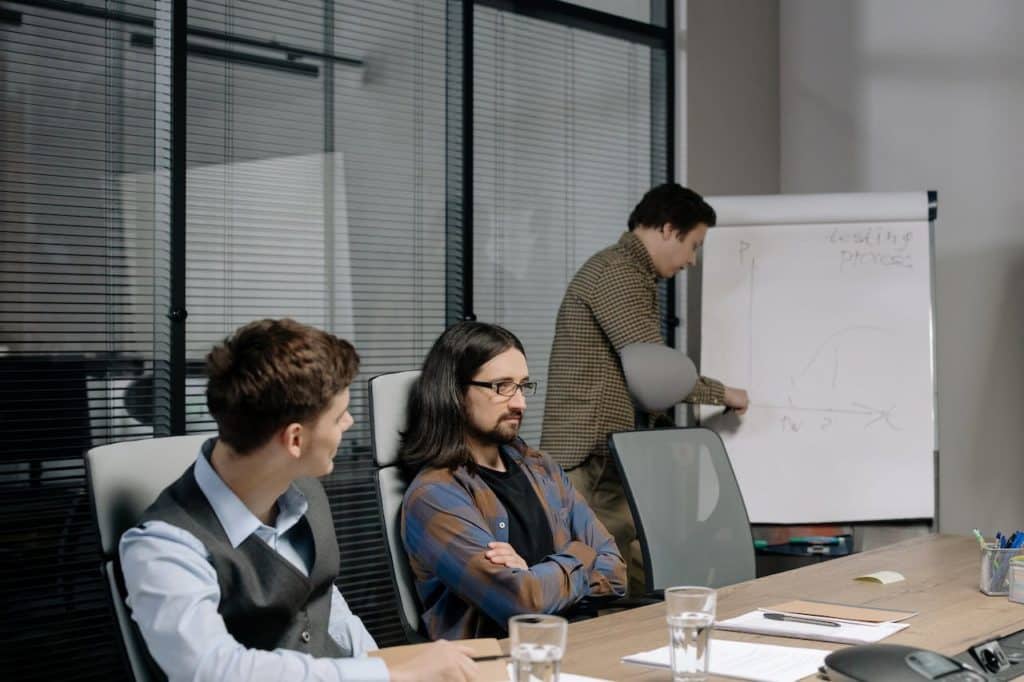The concept of a collaborative tone is fundamental in the context of communication, particularly within a group setting. It is characterized by an atmosphere where mutual understanding and cooperation are prioritized. This approach to communication is centered around the free exchange of ideas, knowledge, and opinions, thereby nurturing a sense of unity and fostering effective teamwork. The essence of a conversation imbued with a collaborative tone is its inclusive nature, where no single contributor overshadows the conversation; instead, it flourishes due to the active participation of all members, each lending their unique insights to the collective discourse.
Definition of Collaborative Tone
A collaborative tone can be thought of as the conversational fabric that binds the members of a team together in their communicative efforts. It acts as an invitation to share perspectives and join in the symphony of a group dialogue. The beauty of such a tone is that it is not monopolized by any individual. Rather, it thrives on the symphony of voices, each contributing a unique strain to the harmony of the group’s effort. This tone is the antithesis of hierarchical or one-directional communication, as it thrives on the collective contributions from every member, each adding value to the conversation.
Importance of a Collaborative Tone in Meetings
In the corporate realm, meetings are more than just periodic gatherings; they are the bedrock upon which decisions are made and organizational effectiveness is forged. A collaborative tone within these sessions is therefore not just beneficial but essential. Such a tone creates a fertile ground for every participant to sow their ideas, cultivating a rich harvest of varied insights which can spark innovative solutions. Moreover, it is instrumental in constructing stronger interpersonal relationships. This is achieved by mitigating conflicts and dispelling misunderstandings, which in turn, augments employee satisfaction and boosts engagement levels.
How to Set a Collaborative Tone in Meetings
Promoting Openness and Trust
To establish a collaborative atmosphere, openness and trust must be treated as sacred principles. When team members sense a safe environment where they can express their thoughts and uncertainties without judgment, they are more likely to engage fully. Trust goes hand in hand with this openness, as it fortifies team unity and fosters a sense of shared responsibility. Leaders can cultivate these qualities by fostering a culture of open dialogue, giving due recognition to all contributions, and demonstrating reliability in upholding their commitments.
Encouraging Equal Participation
Another cornerstone of a collaborative environment is the assurance that each participant’s voice is accorded equal weight. To accomplish this, a supportive setting must be established in which every team member feels their contributions are valued and that they are genuinely encouraged to share their views. Implementing strategies such as rotating speaking opportunities or explicitly inviting thoughts from less outspoken members can help ensure that participation is balanced and inclusive.

Techniques for Setting a Collaborative Tone
Defining Clear Meeting Goals and Expectations Setting an Agenda
Embarking on the journey towards a collaborative meeting tone starts with setting a clear agenda, which should be distributed in advance of the meeting. This proactive step allows participants to prepare adequately, thereby enhancing the quality and focus of the discussion that unfolds.
Clarifying Roles
Additionally, clarifying the roles and responsibilities of each attendee within the meeting is critical. This clarity helps in setting expectations and ensures that everyone is aware of their specific roles, be it leading the meeting, taking notes, or contributing to specific agenda items, thus dispelling any potential confusion.
Fostering Open Communication Facilitating Active Listening
Active listening is a vital component of fostering open communication. It is not merely about hearing words but engaging with the speaker, showing genuine interest, and posing questions that contribute to a deeper understanding. By actively listening, participants show respect for each other’s viewpoints and encourage further dialogue.
Promoting Transparency and Honesty
Creating a transparent and honest meeting environment is another key technique. It requires nurturing a space where honesty is not only allowed but is expected, and where participants can speak their truth without the fear of negative consequences.
Encouraging Mutual Respect Valuing Diverse Opinions
Embracing diverse opinions is essential to a collaborative tone. It involves recognizing and valuing the unique perspectives that arise from different backgrounds, experiences, and cognitive approaches. This diversity is a driver of creativity and innovation, especially in the realm of problem-solving.
Maintaining Professional Etiquette
Lastly, maintaining professional etiquette is crucial. This includes respecting everyone’s time, remaining focused during discussions, allowing others to express their thoughts without interruption, and avoiding personal attacks. These practices contribute to a respectful and professional meeting atmosphere, which is indispensable for effective collaboration.
The Role of Leadership in Creating a Collaborative Tone
Leading by Example
Leadership is fundamental in establishing a culture of collaboration within an organization. Leaders who actively embody collaborative behaviors set a powerful example for their teams. By engaging in active listening, showing openness to diverse opinions, and valuing each team member’s contribution, they create an environment where collaboration is not just encouraged but is the norm. This leadership style plays a vital role in fostering a sense of unity and teamwork.
These leaders often go beyond mere directives; they engage in collaborative projects themselves, showing their commitment to the principle of working together. They understand that their actions speak louder than words and that leading by example is one of the most effective ways to instill a collaborative mindset throughout the organization.
Managing Conflict and Ensuring Fairness
A key aspect of leadership in fostering collaboration is the ability to manage conflict effectively. Conflict is inevitable in any team, but how it’s handled can make a significant difference. Leaders must be skilled in conflict resolution, ensuring that disagreements are addressed constructively and that the final decisions are perceived as fair and balanced.
This involves not only mediating disputes but also creating an environment where open communication is encouraged, and team members feel safe to express dissenting opinions. Leaders must demonstrate impartiality, ensuring that all voices are heard and considered before decisions are made. This approach helps in maintaining harmony and trust within the team, which are essential for effective collaboration.

Challenges in Setting a Collaborative Tone
Overcoming Communication Barriers
One of the challenges in establishing a collaborative environment is overcoming communication barriers. These barriers can be linguistic, cultural, or even due to different communication styles. In today’s global business landscape, teams often comprise individuals from diverse backgrounds, bringing varied communication patterns and expectations.
To bridge these gaps, leaders need to foster an environment of mutual respect and understanding. This might involve providing language support or cultural sensitivity training. Patience and active efforts to facilitate clear communication are key. By acknowledging and respecting these differences, leaders can help build a more cohesive and collaborative team.
Dealing with Dominating Individuals
Another challenge is managing dominating personalities within a team. These individuals can overshadow others and stifle collaborative efforts. Leaders must be adept at recognizing such dynamics and intervening tactfully. This might involve encouraging more reserved team members to share their ideas or setting clear guidelines on respectful communication and turn-taking during discussions.
The goal is to ensure that all team members feel valued and heard. By addressing dominating behaviors and promoting equity in participation, leaders can help maintain a balanced and genuinely collaborative atmosphere.
Training and Tools for Enhancing Collaborative Tone
Training Programs for Team Collaboration
When looking to foster a culture of collaboration, training programs are indispensable. These are tailored sessions designed to impart crucial team-building and collaborative skills. With the right training, team members can understand the importance of every individual’s contribution and learn how to harness collective intelligence effectively.
Such training programs often touch on essential topics such as effective communication, empathy in teamwork, and leveraging the diverse skills of team members. These courses offer both theoretical knowledge and practical exercises to help employees apply these concepts in real-life scenarios. By undergoing these training sessions, employees can equip themselves with the necessary tools to contribute proactively and harmoniously towards collective goals.

Digital Tools to Facilitate Collaborative Meetings
In today’s digital age, leveraging technology is key to fostering collaboration, especially in a remote working environment. Various digital tools are now available to make collaborative meetings more effective and seamless.
Platforms like Microsoft Teams or Slack provide not just video conferencing but also integrated tools for file sharing, real-time collaborative editing, and more. These platforms allow team members, irrespective of their geographical locations, to communicate, share ideas, and work together on projects seamlessly. Zoom, another widely used platform, has gained popularity for its ease of use and features that promote interactivity during meetings.
These digital tools, when used effectively, can greatly improve the flow of information, brainstorming sessions, and overall project coordination, ensuring that every meeting is fruitful and helps drive forward collaborative initiatives.
Evaluating the Success of Collaborative Meetings
Feedback Mechanisms
To understand the effectiveness of collaborative meetings, it’s essential to have robust feedback mechanisms in place. Such mechanisms could range from post-meeting surveys to open forums where attendees can share their thoughts and experiences.
Collecting feedback post-meeting provides insights into areas that worked well and those that require refinement. Such insights are invaluable as they offer a clear direction for making improvements. With regular feedback, teams can identify patterns, rectify common issues, and continuously enhance the quality and productivity of their collaborative sessions.
Key Performance Indicators for Collaborative Meetings
Measuring the success of collaborative meetings requires a structured approach. Utilizing Key Performance Indicators (KPIs) can help in this endeavor. These are specific metrics that provide quantitative data on various aspects of the meeting.
Metrics such as attendee participation level can gauge how engaged team members were during the session. Monitoring action item follow-ups can determine the effectiveness and outcomes of decisions made during meetings. Another critical KPI, decision-making effectiveness, evaluates how efficiently and productively decisions were reached.
By regularly monitoring and analyzing these KPIs, teams can gain a deeper understanding of their collaborative processes, helping them pinpoint areas for growth and ensure that every collaborative endeavor adds value to the organization.
